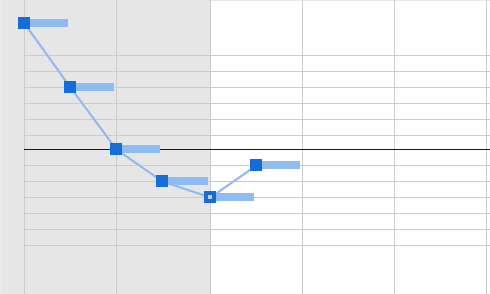Figure

The Figure parameter carries a parametric format of musical expression that is independent of pitch and harmony. It contains Symbols grouped into Segments, the latter of which are responsible for preserving melodic movement and expression, regardless which harmony a Figure is rendered against.
Segments
One or more Symbols are grouped to form a Segment. Segments denote musically meaningful units that are supposed to preserve their relative shape. Symbols in a segment may be stacked vertically (chord), placed in a row (melody), or any combination of the two.

Segments are selected, edited and transformed as a cohesive unit, making them a convenient device for building melodies and musical expressions of arbitrary complexity.
Anchor
Every segment has one Anchor that denotes a point of emphasis that marks the melodically most important symbol of a segment. The anchor is rendered first and then other symbols are rendered relative to it. It also determines the position of the segment on the timeline.
Symbol Types

Symbols are notated on a staff with horizontal lines that, for most symbol types, correspond to the steps of a scale. The bold middle line is a reference that depends on the type of symbol.
- H
- Horizontal: Best for long running melodies relative to the current key. The zero line denotes the root of the Reference Scale of the Global Key.
- V
- Vertical: Best for ornaments, licks or improvised melodies. The root of this scale changes with every chord. The zero line denotes the root of the Vertical Scale.
- C
- Chord / Arpeggio: Best for chords, horn stabs, arpeggios and finger picking patterns. The zero line denotes the lowest note of the current chord in its current inversion and voicing. Each line represents a note in the chord.
- I
- Interval: The anchor describes an interval of the chord. All other symbols are mapped relative to the anchor. Use this type to start a segment on a desired chord interval and let it continue from there.
- P
- Pitch: Absolute pitch. For drums, percussion and other sounds that need not follow harmony. The zero line denotes C4.
- B
- Bass: The zero line denotes the bass of the current Harmonic Context. Each line is a step on the Vertical Scale.
- R
- Relative: The Anchor is mapped like a Chord symbol, while additional symbols are rendered like Vertical symbols relative to the anchor. Use this type to start a segment on a desired chord note and let it continue from there.
- Gray
- Exclusively used by the Take parameter. Absolute pitch.
The best way to make yourself familiar with the different symbol types is to draw a segment in a short Figure and let it repeat over and over while a chord progression moves on.
Positioning Of Segments
The position of a segment in a Figure is determined by its anchor. It is therefore only included with a Span selection if the selection also includes the anchor. Likewise, a segment will not be rendered if its anchor is outside the bounds of a container.
Individual symbols of a segment may also occur at negative positions, that is, before the start of the parameter. Provided the anchor is inside container bounds, such a segment starts playing even before the container begins. This is useful for melodic lines that are supposed to pick up early before moving into a container, or finish gracefully after exiting a container.

Similarly, segments that reach beyond the end of a parameter will continue playing into the next loop or the next container.
Conversion
Drop any parameter with a curve-like shape. The form is preserved as far as possible and values are scaled into range.
Instead of drag and drop, you can also use copy and paste.
Right-click and to insert the current output as a figure with absolute pitch symbols.
Accidentals
Symbols have diatonic and a chromatic component. The diatonic component determines the line on which the symbol is drawn. The chromatic component determines the number of semitones to shift away from that. Although this chromatic shift is called an accidental, its meaning is different from tradition notation.
Figure symbols always snap to the current scale or chord. Whether that note is traditionally notated with an accidental (flat or sharp) or not depends on the key.
Notes may land out of scale only if Voice Leading is bypassed and chromatic shifts are enabled for the segment (Pro). Such chromatic shifts can be pretty harsh. After all, the job of a scale is to make sure all instruments behave in a harmonically consistent manner. The introduction of blue notes or passing tones is a matter of picking an appropriate scale, if only for the duration of a single chord.
The chromatic component of a symbol means: If there is a note in the scale this number of halftones away, use it. So if you have a green chord symbol with a chromatic component of -1, there may be a note in the scale a halftone below that chord tone. If not, the next note in the scale below that chord tone is used.